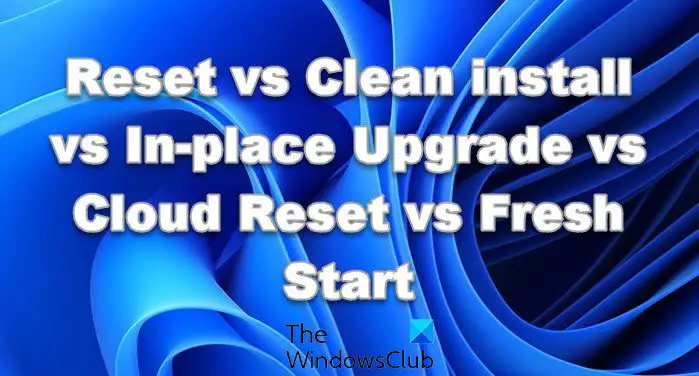Reset vs Refresh vs Clean install vs In-place Upgrade vs Cloud Reset vs Fresh Start
In this post, I will talk about Windows 11/10 Fresh Start, Reset, Refresh, Clean install & In-place upgrade options, so that you know when to use which option: After explaining all of them and their use case, we have put up a small comparison chart at the end with data points for comparison.
1] Reset This PC
Windows Reset will remove everything. If the computer is not working as expected, this is what you should choose. It will do the following:
Reinstalls Windows 11/10 and keeps your personal files.Removes apps and drivers you had installed.Eliminates changes you made to settings.Excludes any apps your PC manufacturer installed.
If your computer came with preinstalled Windows 10, it would also install the apps from the PC manufacturer. When you set it up again, it will be as new as when you bought it. The most significant advantage of using is you don’t need to go through installing Windows 11/10 or the device drivers again. The process will fix it for you as well as improve device performance. The option should be used when your PC is totally messed up or if you are selling or permanently over your computer to someone else.
2] Cloud Reset
Cloud Reset tool downloads a new image from the cloud instead of using the existing Windows 10 files store on the machine. It will reinstall the same build, version, and edition, that is currently installed on your device.
3] Windows 10 Fresh Start
Available in Windows Security app, Fresh Start does the following: This means all your product keys, app-related content, any third-party antivirus will be removed. If you are not able to update to the latest version of Windows, use this method without worrying loss of data. However, you will have to install apps and activate them. UPDATE: Fresh Start has been moved starting from Windows 10 v2004.
4] Refresh Windows Tool
When you Refresh Windows, all apps that do not come with the standard Windows 1o installation, including installed programs, OEM drivers & pre-installed software, will be removed. You may also lose your digital licenses and other digital entitlements. You will have to install your apps and reactivate Windows again. If your Windows 10 computer is facing a lot of issues including corrupt files, then it’s best to use Windows 10 Refresh Tool. The process does the following: It ultimately fixes your computer without you worrying about any data loss. Use it in case you are facing a lot of issues and corruption of system files. To use it, you need to download the Refresh Windows Tool from Microsoft.
5] Windows Clean Install
Clean installation refers to reinstalling Windows 11/10 the old way. You need to download the latest Windows ISO from the Microsoft website, create a bootable USB drive, and then install Windows 11/10 on your computer. It’s the last resort one can take to fix their PC. If nothing is fixing your problem, do this.
6] In-place upgrade
A Clean install refers to installing Windows 11/10 on a computer that does not currently have an OS installed. It is a new OS that is being installed. Windows In-place upgrade is where you already have Windows installed and you use the setup to upgrade it to a newer version. Having an ISO file helps!
Windows Fresh Start, Reset, Refresh, Clean install comparison
I will suggest one important thing. While some of the processes keep your files, it’s always a good idea to back up essential files manually. We usually end up saving files on Desktop and Download folders. Make sure to investigate everything on the C drive and take a backup to an external drive Similarly, if you use a lot of professional software that comes with keys, backup it up using Key Finder Tools. It would be best if you send those keys over an email or backup to a secure cloud drive.
Is it better to reset or reinstall Windows 10?
Windows 10 Reset is more likely to be a basic troubleshooting method and works for fairly basic problems. On the other hand, a Clean Install is an advanced solution for more complex problems. If you are unsure about the complexity of the issue, try on Windows Reset first, if it doesn’t help, fully backup your computer data, and then perform a Clean Install.
Is factory reset the same as PC reset?
The “Reset this PC” feature in Windows resets itself to its factory default state. A factory reset, also referred to as a Windows system restore, returns your PC to the same state it was in when it rolled off the assembly line. It will delete all the files and programs you created and installed, delete drivers and return settings to their defaults. We hope the differences between Windows Fresh Start vs. Reset vs. Refresh vs. In-place upgrade vs Cloud Reset is clear. Always take precautions while performing any of them. Now read: Soft Reboot vs Hard Reboot vs Restart vs Reset.

